What can be said about Root that hasn’t already been said? Since its release in 2018, the game and its publisher Leder Games have racked up a massive pile of awards and helped kickstart a year that’s been defined by games using the asymmetric, faction-based gameplay Root has made famous (plus a notable uptick in murderous woodland critters). I’ll admit I probably can’t add too much to the conversation, but there’s an RPG adaptation on Kickstarter from Magpie Games, a re-release up for pre-order, and a brand new Clockwork Expansion on its way and, frankly, I’ve never been that good at keeping my mouth shut. So here’s the official Fandomentals review of Root: A Game of Woodland Might and Right from Leder Games.
What’s In The Box?
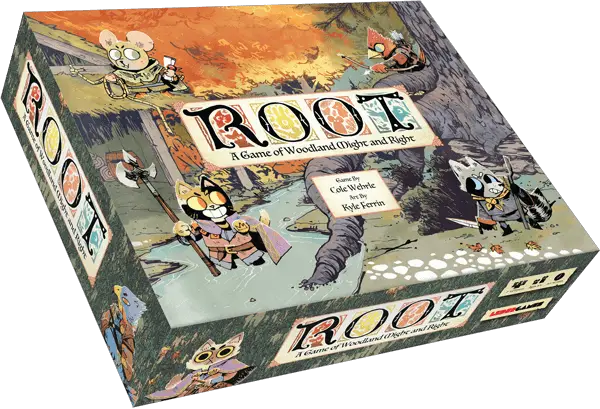
Look, if you’re not already a fan of Kyle Ferrin, who’s THE MAN when it comes to art in Leder releases, then I honestly have no idea what to tell you. The most striking part of this game, from box to board, is the dangerously charming illustrations of the forest and the critters that dwell within it, and it’s this art that really sets the tone for the game. Cute and cozy like you’d expect with a woodland critter theme, it can also be deeply sinister, pulling zero punches when it comes to vulpine cabals or axe-wielding berserk bunnies. The best comparison I’d make, atmospherically, is to Watership Down, Redwall, or even The Secret of Nimh. Yeah there’s cute stuff happening, but underneath it all Root is still, after all, a game about war.
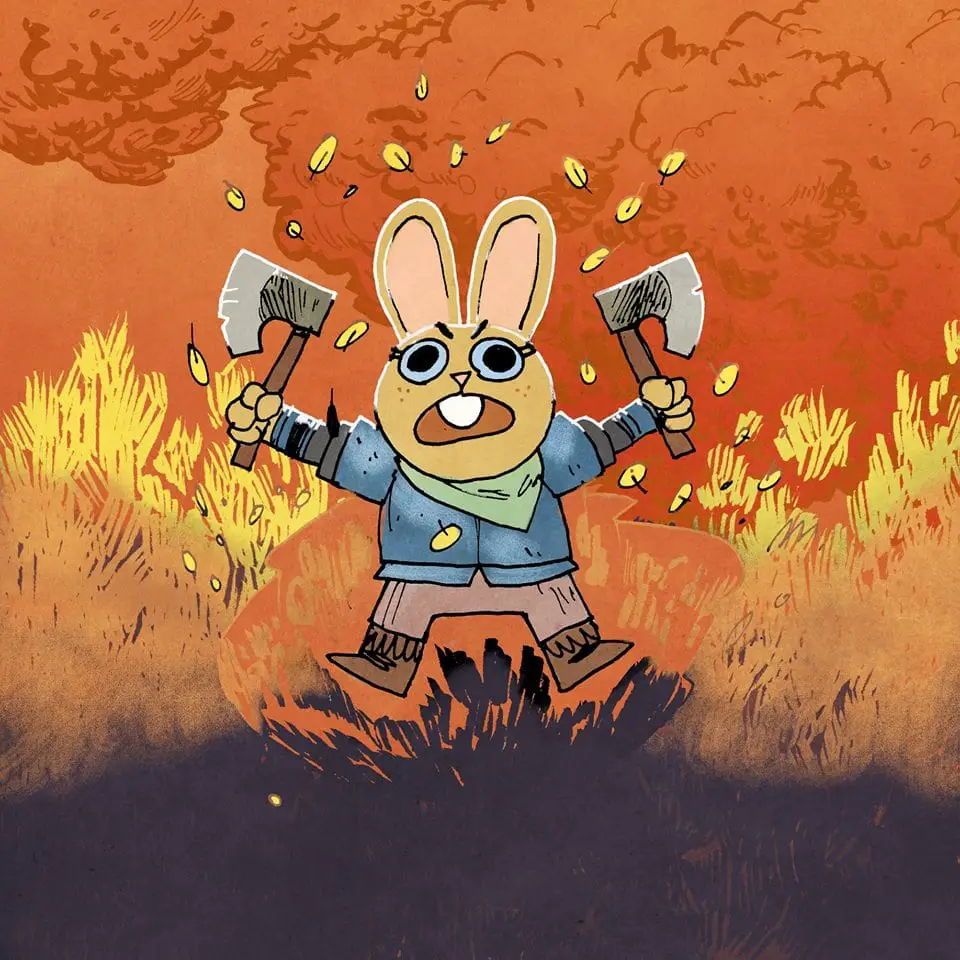
Aside from the art, everything else is top notch. Lots of cardboard, as one would expect, but plenty of lovely, lovely wood as well. The main tokens for each faction are rendered with a clean and simple outline that, along with the vibrant colors, means that even on the most chaotic boards you know where your soldiers are. Each of the meeples also has a cute little face on them which reflect that faction’s general attitude: the smug orange Marquise de Cat, the haughty blue Eyrie Dynasties, the wary green Woodland Alliance, and shifty, solitary, gray Vagabond. The board on which you play has a lot of character in and of itself, with little houses in the villages and signs of life that help the world seem a little more alive. The board is also double sided, with the back showing the forest in winter. Trees are frosted, the river has frozen, and the little houses are all warmly lit and putting out tufts of smoke while their owners, presumably, sit cozily by the fire.
How’s It Play?
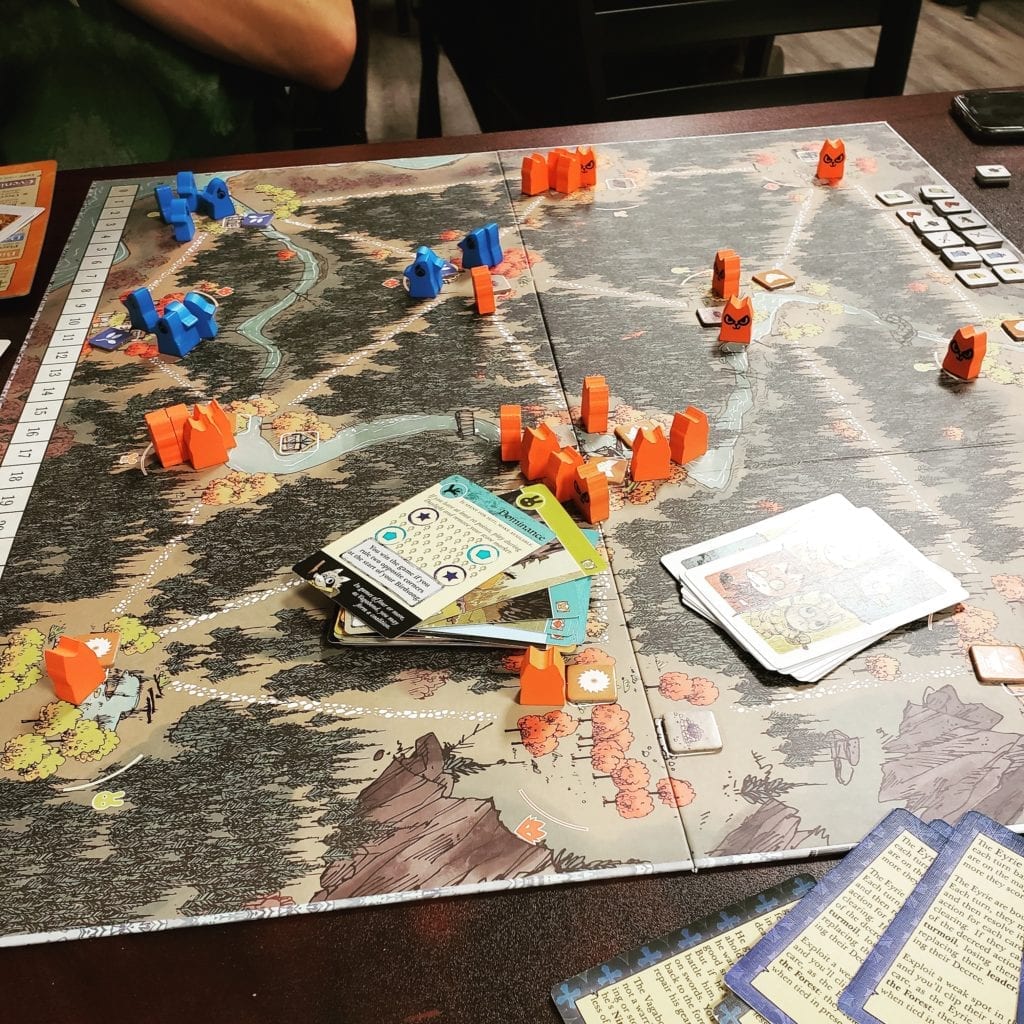
If you’re an experienced strategy gamer, or even if you’ve just played Risk, you can grasp the basics of the game. Use fighters to capture territory, accomplish goals, get stronger, victory dance. First player to thirty points win. But traditional ideas of strategy only really apply to two of the factions. See, the key to Root’s popularity is the asymmetric gameplay, a word that here means all the players are doing what they want even if it means trampling their opponents into the dust. Unlike traditional strategy games, where everyone has the same abilities and path to victory, or co-op games, where everyone is different but working towards a shared goal, players of Root have to strategize around multiple different abilities and win conditions. And don’t worry if you’re a little new to things, the game has basically every contingency known to man baked in. It has explanations for every matchup, every combination of strategies, every skill level. It even has two different ways to learn the game, a more traditional “make your own choices” start and a guided start that holds your hand through the first few rounds until you get the hang of things. There’s also not one, not two, not three, but four instructional books as well as a walkthrough for each faction and a guide for each one so everyone knows who is going for what.
The most recognisable factions, the ones recommended to “beginners,” are the capitalistic Marquise de Cat, who start the game with control and roughly have a “build tall” philosophy, and the aristoctatic Eyrie Dynasties, who start small but have a “build wide” philosophy. In the game’s “story,” these are the factions with the most power and military might at the start, who rely on brute force and numbers to win the day. Each of them has their own “quirk” as well: the Marquise relies on buildings and wood to maintain their holdings while the Eyrie is trapped by its own rigid structure that, if disrupted, can send their whole faction into chaos.
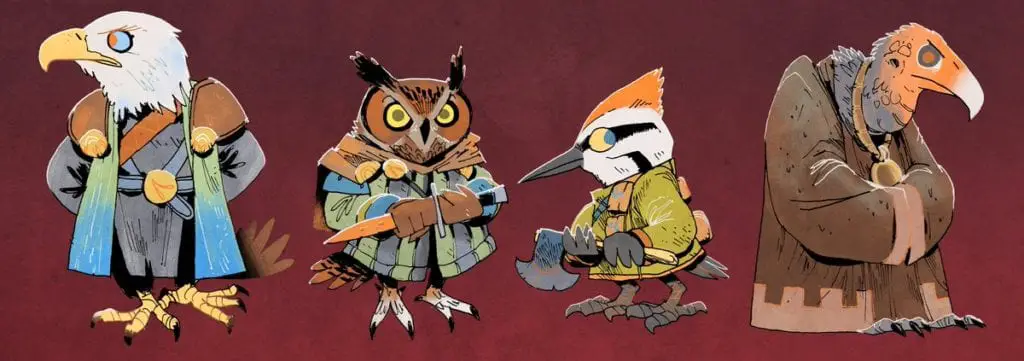
The other two, meanwhile, basically take your expectations of normal strategy and spit on them, mug them, and toss them out back with the filth. The first one, the Toast…I mean the Woodland Alliance, is an adorable version of the Viet Cong. They are the smallfolk, the serfs, the little guys that the big folk step on in their fight for dominance. But they’re tired of not owning their own land, and have risen up to fight back any way they can. Woodland Alliance players have to go with a slow and steady approach, not showing their hands to quickly as they build sympathy and infiltrate the occupied villages. When the time is right, they spark a mass revolt that can take down even the most fortified enemy position. The more battles they have, the more experienced their people get, and the more dangerous they become.
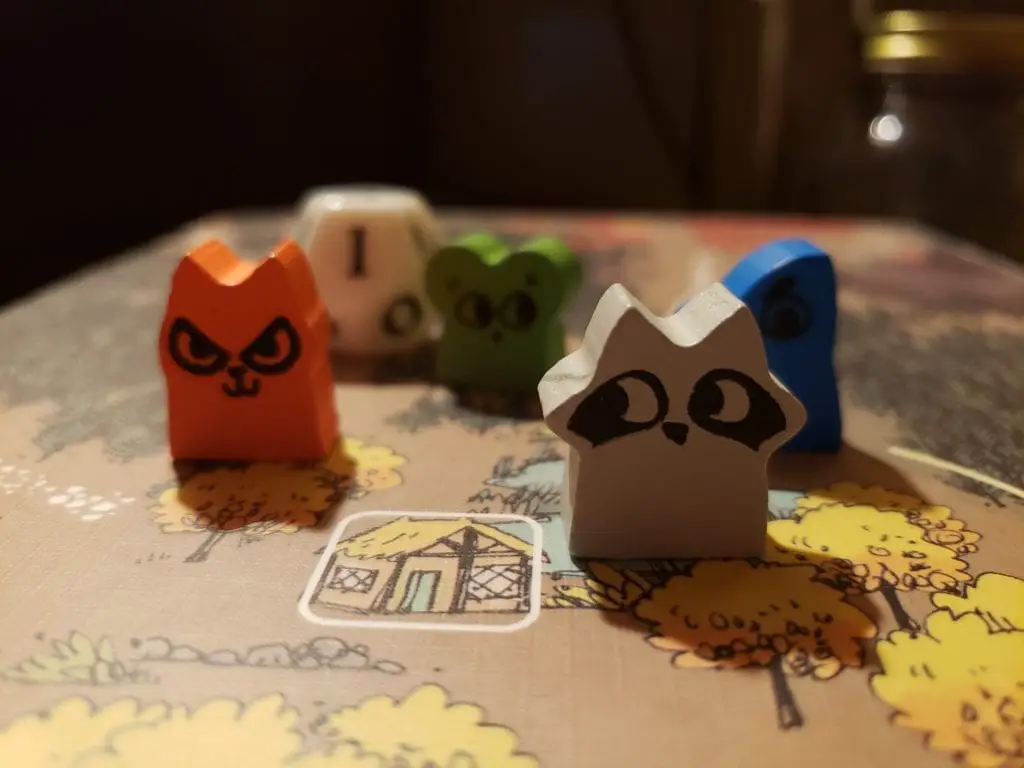
The weirdest dude of the lot is Vagabond, a solitary wanderer who has no real stake in the future of the forest. He’s just trying to make a quick buck off the whole thing. The Vagabond’s goal is to gather items, through trade, theft, or otherwise, and do quests for other factions that not only help him but also makes the factions like him more. He is at various times a sellsword, a wandering adventure, a general nuisance, or some combination thereof, depending on the game. Thanks to his freewheeling ways and cunning intelligence, he’s the only one that can explore ruins and travel through the forest and not need a path. While the Woodland Alliance requires a different sort of strategy than the Marquise and the Eyrie, the Vagabond is almost an entirely different game unto himself. At times, it feels like you’re playing a solo game that dips into your friends’ three-player game except you can totally swing the game one way or the other with just one or two actions.
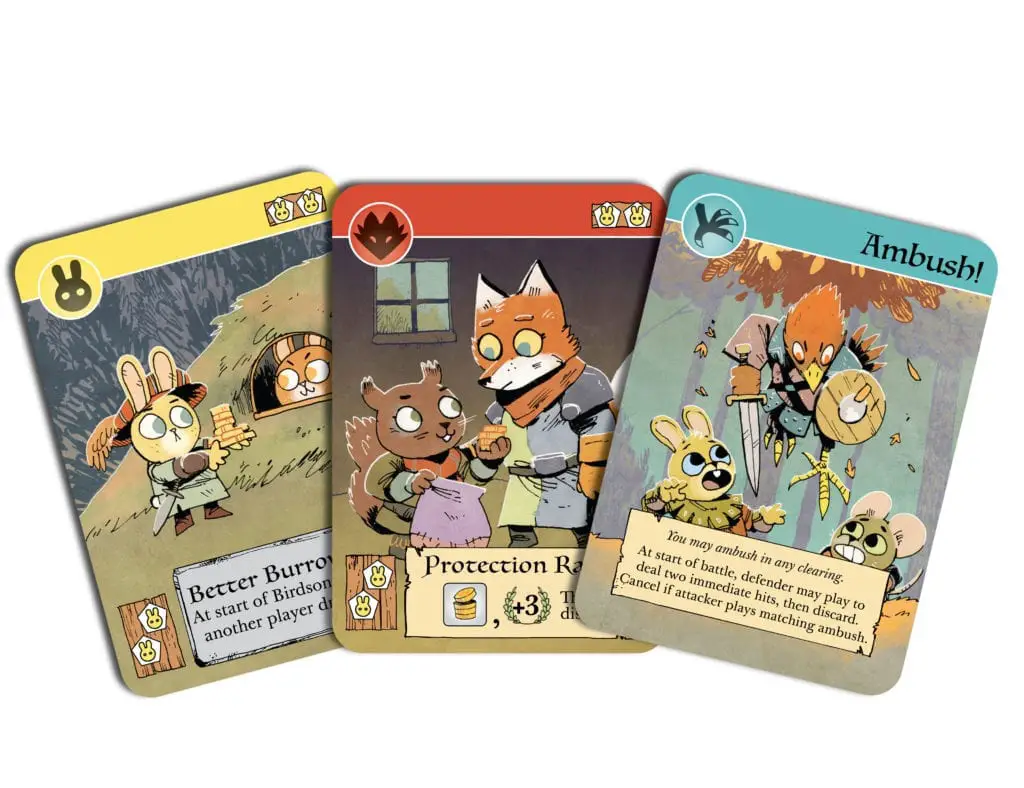
No matter who you play, the last piece of the game are the cards. These are not necessarily an essential path to victory, but they make the process a lot easier and can level the playing field a bit. Most are only craftable if you control the right number of clearings of each suit (Rabbit, Fox, or Mouse), and their effects can be instant (items and victory points) or continual (stealing from other players, peeking at hands). They’re also used as fodder for extra moves (for the Marquise and Alliance) or to dictate strategy (for the Eyrie). There’s also special cards like Ambush, which gives you two free kills on defense, or Dominion cards, which change your win condition from scoring 30 points to controlling a certain amount of territory for a full day.
Combat in the game is pretty simple. You roll the two hit dice (specially made d10s that are really chunky and pleasant to roll) and then deal as many hits as you get up to the amount of meeples you have in combat. Attackers take the higher and defenders the lower (except for the Alliance, they always take the highest), and then the hits are dealt and dead tallied up. The pure RNG of the combat can be a little frustrating at times, and an unlucky series of rolls can lead to a player going from total dominance to abject failure in just a few turns. This becomes less of an issue in bigger games, when the presence of the Alliance and the Vagabond can even things out, and the cards often help make things a little easier as well.
The Verdict

Root is pretty much a must-have at this point. I think most people with even a passing awareness of board games are starting to notice a rectangle-shaped hole on their shelf where Root should be. It’s easy for beginners as a gateway to more advanced board gaming while also offering a challenge to even the most experienced players. It’s also incredibly replayable thanks to each faction having multiple ways to play and the game itself being incredibly fluid and varied just from game to game. And that’s not even getting into the Winter Board. There’s a completeness to the game, a sort of holistic approach to gameplay that few other games can really come close to. Everything is accounted for, every eventuality has an explanation, everybody feels welcome.
Strange as it sounds for a strategy game about war and battles for supremacy, Root is a cozy game. When you’re playing it, it’s easy to smell smoke drifting through the morning air, hear birds chirping, feel the last chill of the day dissipate with the rising sun. You want to wrap yourself in a scarf or a coat, go sit by a fire, maybe make a pot of tea. When you get to know Root, you really start wanting to play it more. That feeling is what I think people like about it as much as the innovative gameplay and fun mechanics. It is, for lack of a better phrase, cardboard comfort food.
Root is currently available for pre-order through the Leder Games shop, with the Riverfolk Expansion (adding in the Lizard Cult and the Riverfolk Company) and the recently Kickstarted Underworld Expansion (which adds the Great Underworld Duchy and the Corvus Conspiracy factions as well as two new maps) hopefully being in stock soon. There’s also still a few days left on the Root RPG Kickstarter, the free Quickstart of which is available on DriveThruRPG.

